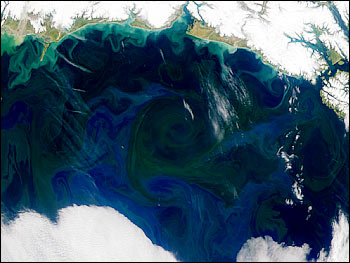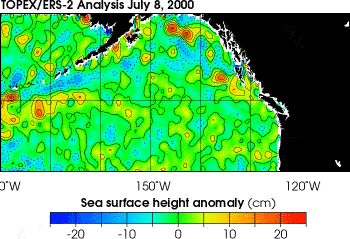

 |
|||
Vortices of water, called "eddies," form off the
northwestern coast of North America in the winter, and are particularly
large during El Niño winters when warm waters along the coast
flow northward at greater speed than normal. These eddies carry local
nutrient-rich waters far offshore into regions with low ambient nutrient
levels. As the eddies transport fresh water and nutrients out into the
middle of the Gulf of Alaska, they provide nourishment for
phytoplankton—microscopic plants that form the foundation of the marine food
chain. (To learn more about these tiny plants, read: What are Phytoplankton?) How important are these eddies for the Gulf’s ecosystem?
It is hard to answer that question now but, in one example, scientists
say it is possible that variations in the size and frequency of the
eddies are one of the factors governing the success of salmon in the
open ocean. |
|||
 Recently, Canadian and American scientists teamed up to collect and analyze data from satellite and ship-borne sensors taken over the region. With these data, they set out to determine the properties and behavior of the eddies and measure their impact on the Gulf of Alaska’s ecosystem. The researchers found that the eddies, particularly those created during El Niño years, can last several years. They found that the eddies migrate slowly through the Gulf, moved about by shifting currents, and replenish nutrient-starved regions with iron and nitrate. "Our concern over the depletion of fish in this region makes
satellite altimeter measurements such as TOPEX/Poseidon data
particularly important in understanding the formation and movement of
these nutrient-rich eddies, and how they influence salmon growth and
other fisheries," says William Crawford of Fisheries and Oceans
Canada at the Institute of Ocean Sciences. |
Eddies are rotating masses of water in the ocean that typically form along the boundaries of ocean currents. In the Gulf of Alaska, eddies of warm water, filled with nutrients from shallow coastal water, mix with the cold water off the continental shelf. The mixing fertilizes the nutrient-poor water of the gulf, resulting in blooms of phytoplankton (microscopic ocean plants.) This true color image from the Sea-viewing Wide Field-of-view Sensor shows the green spiral of an eddy in bright blue water. Also notice the sediments suspended in the water along the south coast of Alaska. (Image provided by the SeaWiFS Project, NASA/Goddard Space Flight Center, and ORBIMAGE) | ||
 |
 In 1998, he and colleague Frank Whitney began using TOPEX/Poseidon images produced by the University of Colorado to track the large-scale eddies. The satellite data, along with in situ data collected aboard a Canadian Coast Guard Ship gave Crawford and Whitney unique insight into these eddies as a natural mechanism for nourishing the sea. The data used in this study are available in one or more of NASA's Earth Science Data Centers. |
Satellites monitor movement and evolution of eddies continuously. Using radar that sees through clouds, the TOPEX/Poseidon mission and the European Remote-Sensing Satellite-2 (ERS-2) produce maps of sea surface height. Since eddies that are warmer than the surrounding water are higher than the usual sea surface height, they appear on these maps. This image shows the difference from normal sea surface height for the northeastern Pacific. Warm core eddies appear as red circles. (Image courtesy Colorado Center for Astrodynamics Research) |